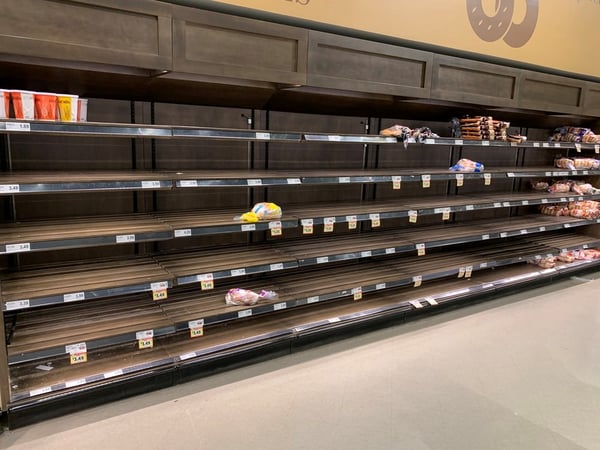The Internet of food and the role of online platforms
In the last decade, our lives have largely moved from “bricks” to “clicks”, shifting from a physical dimension to the digital world where most transactions are concluded online. Internet-based platforms are the leading actors of this technological shift and unquestionably stand at the heart of today’s digital economy.
It's difficult to identify an economic area that has not been touched, in one way or another, by online platforms. They offer outstanding advantages, including a new outlet for goods and services, easier access to information and content in general, a large variety of choices, real price competition and new business opportunities. They also come in all shapes and sizes, from micro-businesses to multinationals, and some of them are today true economic titans.
The food sector is no exception.
Until recently, food innovation generally happened in laboratories and mostly involved new techniques of agricultural production (think about GMOs!). Then the digital revolution hit the food sector, as any other industry, and the internet became the instrument through which the agro-food chain started one of its most drastic makeovers.
Free whitepaper: Safety and potential allergenicity of foods from genetically modified crops
Purchasing food online is usually done in the form of groceries, meals or meal kits. For instance, food producers/traders may build their own selling website, or trade via third-party platforms or even use social media to advertise products. Eating-places (from local delis to high-end restaurants) may use delivery platforms to connect with customers, allowing them to choose from an entire buffet with just a tap on their smartphone. Through meal kit platforms, users may order a box full of fresh food products and cook meals following the kit’s instructions and recipes from – often-renowned - chefs.
The online food industry’s growth rates all around the world have hit the roof in the last 5 years, proving that millions of consumers are more keen on having groceries and meals delivered at the press of a button rather than wasting their time finding a parking spot to go grocery shopping or spending their evenings in front of the stove.

Europe is home to some popular food delivery platforms (Just Eat, Deliveroo, Glovo and Foodora, to name a few) and even the ones that were not born in the old continent (Such as Uber Eats, Amazon and Alibaba) are embedded into the everyday lives of millions of food consumers. In general, the business of delivering food to homes is undergoing rapid change across the Americas, Asia, Europe, and the Middle East.
There’s more. Recently, an increasing number of food online platforms have pledged to make a real impact on the environment, sustainable production or social assistance. For instance, Barn2Door connects farmers to customers through a web platform that integrates online and local sales. La Ruche Qui Dit Oui! is an online platform that links consumers with local producers for the trade of foodstuffs produced within a short distance from the point of distribution in France. The Copia platform connects businesses with excess food – such as restaurants – to people in need, with the double aim of fighting against food waste and redistributing food to those who need assistance.
Digital food innovation is in constant growth, with one of the most recent phenomenons virtual restaurants or 'ghost kitchens' - restaurants made of kitchens only and a counter/window that allows riders to take on the food and deliver it.
Food delivery during COVID-19 pandemic
The global COVID-19 pandemic has only made obvious the crucial role played by food delivery platforms in the lives of today’s food consumers. We are stuck in our homes, but with the shelves of our pantry full of food!
As now millions of people are being asked to stay home to contain the health crisis, online food distribution has become one of the main protagonists of the 2020 quarantine. Consumers have turned to online grocery providers as a safer alternative to shopping in stores, and the closure of bars and restaurants to the public was also one of the first measures put in place by many governments, forcing businesses to increase or in some cases build from scratch their online presence.
Supermarkets have seen an unprecedented demand for food, which has caused a short circuit of the delivery system, and constrained marketplaces to wait list customers, expand the number of pickup stores, and create delivery windows. Meal delivery platforms have seen apps downloading go up the charts. With all the applicable challenges in terms of logistics and hygiene-sanitary control plans to put in place in record time.

Internet: a privileged channel for unsafe food
Although food delivery platforms are dominating consumer trends and attracting considerable investments, little has been done in terms of regulating them, including in Europe. Indeed, and regardless of all the challenges raised by food online platforms during COVID-19 (let’s think of food safety, hygiene of packaging, and health of customers and riders), the law has been strangely silent in facing the issues raised by food online.
In particular, while food e-commerce is rapidly developing, the amount of products traded online that may be harmful to consumers is regrettably growing too.
In September 2017, the European Commission implemented the first European Union (EU) coordinated control plan (CCP) on online offered food products. The CCP’s goals were to boost Member States’ surveillance of the e-commerce food market and to promote the use of the electronic systems put in place by the EU to control the quality and safety of food (especially the Rapid Alert System for Food and Feed).
On a voluntary basis, Member States were asked to search for products non-compliant with EU food law. In order to avoid an overload of control authorities’ capacities, the plan dealt with only two specific infringing products: non-authorised novel foods and food supplements with health claims.
As it was to be expected, an impressive number of unlawful food products were found to be offered online. The food supervisory authorities mainly focused on traders based nationally. In some cases, they also identified offers in their respective official languages from traders located in other EU Member States or third countries, in particular in the United States and China.
The Commission’s subsequent analysis of the CCP’s outcomes concentrated on strengthening the coordination between competent authorities, training staff in online investigations and establishing contact points with major e-platforms, reminding all key players – including platforms - of their responsibilities for ensuring that safe and non-misleading food is offered to EU consumers.
However, these responsibilities still remain unclear, creating huge uncertainty and risks to consumer safety.
Where does food online regulation stand in Europe?
In recent years, in the EU, some legislative rules specific to food online have popped up now and then, demonstrating that the phenomenon is not unknown to the EU regulators.
The Food Information to Consumers Regulation (Regulation 1169/2011) entered into force in 2014, stating that information requirements for food sold in physical shops apply to food supplied through distance selling, but specifying that in such cases the relevant mandatory food information should also be available before the purchase is concluded (Recital 27). Specifically, article 14 reaffirms that mandatory food information is to be available before the transaction is completed, appearing on the material supporting the distance selling or be offered through other appropriate and clear means.
The only food information which is not require to be provided prior to purchase relates to the date of minimum durability, or the ‘use by’ date. Such exemption is of a practical nature. Considering that web windows do not typically show the actual product sold but just a sample, it would be impracticable to keep track and update the digital image on a daily or weekly basis. When non-prepacked foods are offered for sale by means of distance communication, only information on ingredients causing allergies or intolerances must be provided both prior to the purchase and at the moment of delivery (see articles 9,14, 44 of the Regulation).
Moreover, the new Official Controls Regulation (Regulation 625/2017) just became applicable - for its main part – last December, and provides for detailed rules on governance and control of the agri-food chain in Europe. It specifically tackles online controls, by finally authorizing national authorities to engage in mystery shopping when conducting official controls (article 36). Plus, the new Regulation provides the legal basis for competent authorities to close websites where operators do not comply with applicable food laws (article 138(2)(i)).
Apart from these ad-hoc provisions included in more general legislative measures, the EU has been rather timid when it comes to food online regulation. This uncertainty may be explained by several factors, starting from online platforms’ doubtful position in the context of EU General Food Law (Regulation 178/2002). According to article 17, all food business operators (FBOs) at all stages of production, processing and distribution of food have the responsibility to ensure the safety of food. However, most online platforms involved in the food chain are mere intermediaries to products sold or prepared by others. Could we define online platforms as FBOs since they usually do not own and in some cases never physically handle food?
This and many more questions (how to enforce illegal food sales on the web for one) show how online food sales raise legal issues way beyond these sporadic legislative interventions. As we cannot consider food e-commerce a niche market anymore, it is important for food online platforms to have a clear understanding of their status, responsibilities and enforcement powers in relation to food safety. Indeed, regulatory inertia shows itself to be rather hazardous when values such as food safety and human health are put at risk.
Related:- Keep up-to-date with legal developments in food
- Food authenticity testing: a positive approach in combating food fraud
- Food safety in China
References
FORCUM M. A., From Silicon Valley to the kitchen table: innovative online agriculture and food start-ups and the Law, in Kentucky Journal of Equine, Agriculture and Natural Resources Law, 2014, volume 7, issue 2, pp. 327 ss;
HIRSCHBERG C. et al., The changing market for food delivery, McKinsey&Company Article, November 2016;
McGLINN M., Food Delivery Platforms – Transforming Operations, in Food On The Move, 12 November 2018;
MERTEN-LENTZ K., How online sales of food pose a regulatory challenge in the EU, in Tomorrow’s Food and Feed, Keller and Heckman LLP, 7 January 2020;
PEREZ S., Walmart Grocery app sees record downloads amid COVID-19, surpasses Amazon by 20%, in TechCrunch, 9 April 2020;
PEREZ S., Amazon puts new online grocery shoppers on a waitlist, in TechCrunch, 13 April 2020;
PITOZZI A., Quasi due prodotti su tre venduti via ecommerce non sono sicuri, in Wired, 25 February 2020;
SINGH S., The Soon To Be $200B Online Food Delivery Is Rapidly Changing The Global Food Industry, in Forbes, 9 September 2019;
VAN DER VEER L., Food online: radical changes to the digital shop window, in European Food and Feed Law Review, 2014, n. 2, pp. 78 ss;
WHITWORTH J., WHO and EU Commission publish coronavirus food safety advice, in Food Safety News, 14 April 2020;
European Commission, Overview Report of a series of fact-finding missions carried out in 2017 concerning Official Controls on Internet Sales of Food in EU Member States, DG(SANTE) 2018-6537;
UK Food Standards Agency, Food safety for food delivery. Hygiene and allergy advice for takeaways and food delivery businesses, 26 March 2020.


